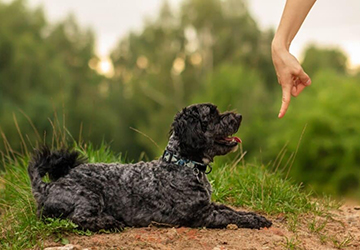As a dog owner, you have an essential responsibility to train your four-legged friend properly. Teaching obedience cues and commands is necessary for establishing a healthy human-canine relationship built on communication, respect, and safety.
Luckily, there are six basic commands that every dog should know. These essential skills will allow your dog to be a happy, obedient family member.

6 Essential Commands Every Dog Should Learn
Discover the six essential commands we highly recommend every dog learns. By the end of this post, you'll have the knowledge and techniques to start training your dog immediately.
Establishing these key behaviours early on will set you both up for success as your bond grows.
1.Sit
The "sit" command is often the first cue owners teach puppies. Hold a treat over your dog's head and move it back towards their tail to train it. This lures them into a natural sitting position.
Say "sit" when their hindquarters hit the ground, then reward and praise. Mastering this impulse control game establishes you as a pack leader while building communication.
Practice daily in 5-minute sessions either before meals or during play for best results. Be patient - some pups may take weeks to connect the verbal cue with the action.
2.Come
A reliable "come" is the most vital command dogs can learn. If they escape thpup'sr or slip off a leash, it may save your pup's life.
Start training recall on a long line in low-distraction settings using high-value treats and ecstatic praise so that coming back feels rewarding. Practice for a few minutes daily, gradually adding distractions over a month.
Eventually, transition to off-leash and use real-life rewards like throwing a ball. Consult a certified trainer if your dog struggles with this cue despite best efforts.
3.Stay
The"sta" command teaches patience and impulse control. Start with your dog sitting. Give the cue" stay", take one step back, then return and reward.
Gradually increase your distance and duration over multiple training sessions until your dog holds the stay for 30+ seconds as you walk around the room. If they break position, gently lead back and practice more reps.
Always reward success, finally. This command requires great perseverance for both owner and pup but creates trust and focus.
4.Down
Mastering the" dow" cue promotes relaxation in excited pups and prevents jumping on guests. Have your dog sit first, then hold a treat by their nose and guide it straight towards the floor.
Their head will lower into a prone position as their elbows touch down. Say" dow" then and give the reward. Only proceed to add verbal cues first once the luring action is reliable. Practice a few minutes daily.

5.Leave It
One of the most valuable commands for redirecting undesirable behaviours like chewing, chasing cats, or jumping on tables is"Leave it." Place a tempting item on the floor and cover it with your hand.
When your dog investigates, say a firm" Leave it" in a low tone. Remove your hand only once they lose interest. Reward that self-controlled choice to walk away by praising and giving a high-value treat from your other hand instead.
6.Heel
Proper leash walking manners start with a solid" hee" command. With your dog on a leash next to you, tempt them into a perfect heel position by your leg using a toy or treat. Take a few steps forward, then stop and reward in the proper place again.
Build duration gradually over weeks, randomly changing direction to maintain engagement. Praise focused attention. Aim for loosely walking in sync without pulling eventually.
Teaching heels creates structure during walks and tires pups mentally, too.
Conclusion
Training your dog using positive reinforcement and patience is critical for mastering these six essential commands. Sit, come, stay, down, leave it, and heel establish vital communication, impulse control, and safety skills for pets.
Practising 5-10 minutes daily in distraction-free environments creates a foundation for lifelong good behaviours and a happier human-canine bond.
FAQs
Q: What are the easiest dog tricks to teach first?
Ans: The easiest dog tricks to start with are sit, come, and down. These basic obedience cues help establish communication and connection between you and your pup. Reward your dog with treats and praise to reinforce positive behaviour as you train.
Q: Should my dog know these six commands before age 1?
Ans: While every dog learns at a different pace, most dogs can master these essential six commands by the age of 1 with consistent training. Start small with 5-10 minute daily training sessions and try to end triumphantly to keep it enjoyable for your puppy.








